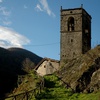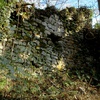Castle of Roccalberti
Situated halfway up the western slope of Monte Casatico, the fortress dominated much of the valley of the Edron river and the confluence of the latter with the Serchio river. There were many castles over which the fortress could exercise its power and among them, there are the hillock of Capriola, Sambuca and Sillicagnana.
The walls of the fortress enclosed a fairly large area and within them there were numerous housing structures. Currently only a few mediaeval structures from the twelfth and thirteenth centuries still remain standing, mainly because of the violent earthquake that shook the Garfagnana in 1920, which destroyed the parish church. One of the windbreak towers with a semi-circular base is positioned along the north curtain of the surrounding wall, but it seems to be a post-mediaeval addition.
Historical notes
During the tenth century, the Bishop of Luni granted the "villa" to the Alberti nobles and its name comes from this family, who were married into the Malaspina family and the Fieschi di Lavagna counts. The site, as the name suggests, was prematurely fortified and a place of worship called "Chapel de Rocha" was also erected inside the fortress which first appears in a document from 1297.
At the beginning of the fourteenth century, Castruccio Castracani forced the last lords of "Roccalberti" to relocate to Camporgiano and in this way the castle was acquired by the government of Lucca. A few years later, the castle was assigned - together with other fortresses of the Garfagnana - to Spinetta Malaspina who, in 1345, decided to sell these lands to the Florentines. It was only in 1369 that Lucca was able to regain possession of the Alberti stronghold. The settlement is not mentioned in the Golden Bull (1376), but appears in a list drawn up in the next century by officials in Lucca which included the important fortifications for defending the borders. After the destitution of Paolo Guinigi (1430), the fortress entered spontaneously into the domains of the Marquis of Ferrara to protect itself against raids carried out by Florentine soldiers.










